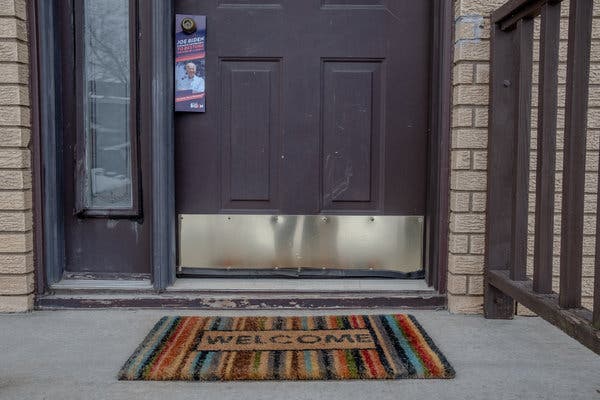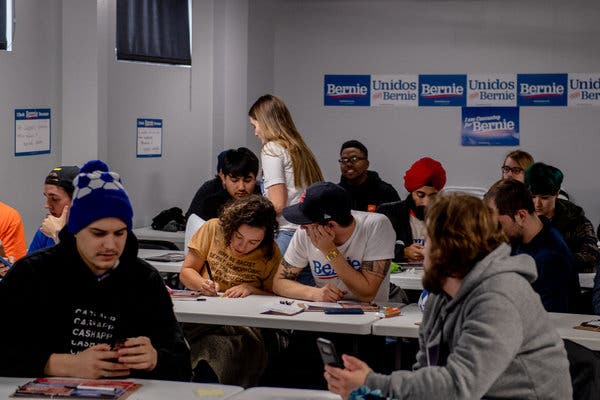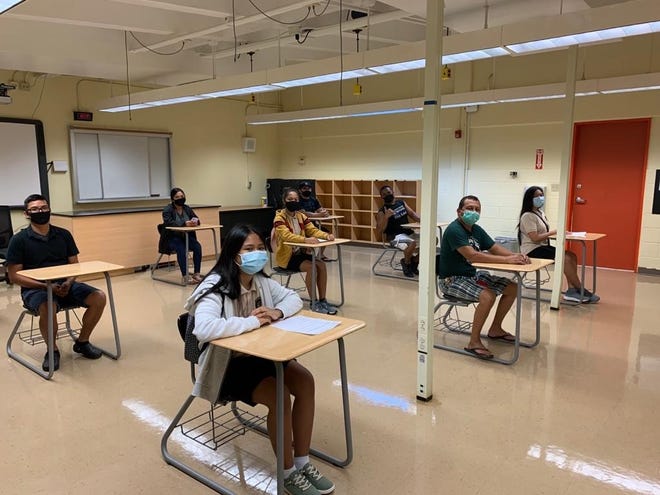Advertisement
Candidates and political parties are struggling to plan for a fall campaign without some of the most basic building blocks of politics.

Joseph R. Biden Jr. went door-to-door in his first Senate race in 1972, and had volunteers hand-deliver mailers. In 2018, Alexandria Ocasio-Cortez walked across her district until rainwater seeped through the soles of her sneakers. This past winter, Bernie Sanders’s presidential campaign mobilized an army of supporters to hit more than 800,000 doors ahead of the Iowa caucuses.
But in the fall of 2020, volunteers might have to knock on a door and then sprint 10 feet away, making a pitch from a safe social distance. That is one tactic some strategists have floated as they consider a pandemic-safe update to a fundamental political tool: the humble door knock.
For decades, showing up on a voter’s doorstep has been one of the most reliable ways to get people to the polls. Now political parties and candidates that put tens of millions of dollars into training and deploying door knockers are grappling with costly, consequential and imminent decisions about whether they should even invest in traditional brick-and-mortar infrastructure that powers such operations.
Campaigns face a dilemma, even as they put on a happy face about their seamless transitions to a forced all-digital reality: Don’t invest and risk falling behind on a field operation (if door knocking does become realistic). Or spend money now on offices, computers, clipboards that could sit idle in October, and waste time training traditional canvassers.
For now, nearly every campaign at every level is rushing to fill the breach with virtual programs that no one has ever depended on like this — or tested at such a scale.
“Campaigns don’t need a new ‘Plan B’ for field. They need a new ‘Plan A’ because door-to-door canvassing is not going to happen at scale in the 2020 election,” said Becky Bond, a Democratic strategist who worked on Beto O’Rourke’s 2018 Senate campaign and specializes in developing field programs that use technology.

Or, as Ari Rabin-Havt, deputy campaign manager for Mr. Sanders’s 2020 campaign, put it, “Even if there are official pronouncements of the country opening back up again, are people going to open the door for strangers at their houses?”
What physical campaigning will look like this fall is especially important for Mr. Biden, the likely Democratic nominee, who has a far less robust digital presence than President Trump. Mr. Trump enters the race with other advantages of incumbency, including a vast financial edge, a unique ability to command attention and a supporter base that has proved particularly enthusiastic and durable. Mr. Biden won the primary in spite of a field operation that had a more limited presence on the ground than his leading rivals almost everywhere.
“They really didn’t have much of an operation as far as I could tell,” said Claire Sandberg, the national organizing director for Mr. Sanders. “They were way behind.”
Contacting voters by the millions does not happen overnight, and late spring is often when hiring ramps up. Campaigns typically must rent field offices, train organizers and recruit volunteers. That first wave of volunteers recruits the next wave and so on, ideally a gradual build that grows exponentially.
“It’s not something where you can flick a light switch. It is more like a ship you have to launch early,” said David Bergstein, a spokesman for the Democratic National Committee, who said the party had shifted to an all-digital field program.
That cycle — at least the in-person portion — has been halted for the foreseeable future as volunteer recruitment and organizing have migrated fully online. But Ms. Bond warned Democrats against any disinvestment in “human-to-human interactions” — even if done virtually. “We’ve already seen Trump beat a Democrat that failed to run a big enough voter-contact campaign in enough states to win the Electoral College,” she said.
Up and down the ballot, campaigns in battleground states are assessing the effectiveness of texting efforts, Zoom calls for volunteers and remote organizing.
In Minnesota, the chairman of the state Democratic Party said it had put on hold plans for 30 additional offices in a state that President Trump has vowed to contest. “There’s no reason to incur the expense,” said the chairman, Ken Martin, who leads the Minnesota Democratic-Farmer-Labor Party and is vice-chair of the national Democratic National Committee, citing the uncertainty of the fall.
In Florida, the executive director of the state Democratic Party, Juan Peñalosa, said the party already had nearly two dozen offices but was adding new skills and social-media account information to its job listings. “We need to get used to the new abnormal,” he said. More than 100 campaign staff members have shifted to all-virtual organizing.
In Wisconsin, Ben Wikler, the state Democratic chairman, called an April election held during the pandemic a “dress rehearsal” for November. He said that election fundamentally “changed the role of volunteers from being a reminder service to a tech-support team,” helping voters request vote-by-mail ballots.
“We’ve converted one of the country’s most intensive door-knocking operations into one of the country’s most intensive screen-pinging operations,” he said, adding that the focus now was on new hires’ having laptops and high-speed internet, rather than on opening new offices.
The Republican National Committee said that the party had more than 800 field organizers spread across battleground states already, but that it had started moving away from organizing in physical offices after 2016. “That traditional brick-and-mortar just didn’t make sense anymore,” said Rick Gorka, a spokesman for the committee, adding that volunteers had made 20 million voter contacts by phone since mid-March.
Groups that specialize in door-to-door campaigning must figure out how to make up for lost time.
Matt Morrison, executive director of Working America, a political organizing arm linked to the A.F.L.-C.I.O., said his group, with a $70 million budget goal, suspended canvassing operations in mid-March and projected that delaying restarting until June with the same level of investment would mean only 700,000 conversations by Election Day instead of two million.
He is worried about what that means for Democrats. “Trying to beat Trump at the earned media game hasn’t really worked out so great,” Mr. Morrison said. “If anything, having face-to-face and relationship-based interactions becomes disproportionately valuable.”
Door knocking is not just some romanticized notion of how campaigns should work. Strategists point to political science research showing that in-depth and in-person conversations are particularly effective tools at moving votes.
“We definitely know that door-to-door canvassing can meaningfully impact voter turnout,” said David Broockman, a professor of political science at the University of California, Berkeley.
Because of that, “if there is any way to do it safely and responsibly, we will door knock in the fall,” said Jessica Post, the president of the Democratic Legislative Campaign Committee, which is devoted to winning seats in state legislatures.
Similarly, campaigns have turned to what is known as relational organizing, asking supporters to plumb their own contact lists to make calls instead of phone-banking strangers.
In March, Mr. Biden installed a new campaign manager, Jennifer O’Malley Dillon, who had overseen the 2012 field operations of President Barack Obama’s re-election. People who have worked with Ms. Dillon describe her as a particularly field-focused tactician.
The Biden campaign has tried to swiftly shift its outreach to be fully digital in recent weeks, empowering volunteers to create their own pro-Biden content via Slack channels, organizing remote phone-banking and starting to form like-minded communities of supporters online.
“Obviously this is one of the odder times people have ever lived through,” said Molly Ritner, Mr. Biden’s states director, adding that the campaign was planning for a range of possibilities this fall. “I think that connecting with people on a one-on-one level will be incredibly important in this campaign.”
Making those connections can be complicated. The Biden campaign still has not begun using some of the more modern dialing technology on the market, which automates the calling process and helps connect volunteers immediately to real supporters.
Instead, the campaign is using a system that multiple operatives described as slow, cumbersome and clunky.
One big decision for the Biden campaign, Ms. Dillon and the Democratic National Committee: what to do about an unusual group called Organizing Together. The organization formed this year with the explicit mission to build an enormous field program in six key battleground states — Arizona, Florida, Michigan, North Carolina, Pennsylvania and Wisconsin — and then disband after handing its staff and office leases over to the Democratic nominee.
“We’ll stop operating as soon as their field operations are set up,” said Jane Slusser, the group’s national director.
The effort was an outgrowth of frustrations from Hillary Clinton in 2016 that she inherited so little from the D.N.C. and of fears that a prolonged 2020 primary would hobble whoever emerged as the nominee.
But now it is not clear, given the current conditions, if the joint Biden-and-D.N.C. operation — which entered April with $187 million less in cash on hand than Mr. Trump and the Republican National Committee — will even want to absorb the cost of these field organizers. The D.N.C. is understandably partial to its own field program, according to people familiar with the matter. Ms. Slusser said in late April that Organizing Together had already hired more than 230 organizers with plans to roughly double that figure by the end of May.
The Biden campaign and D.N.C. declined to comment on any plans for the Organizing Together corps. Other organizers competing for jobs include alumni of the Michael R. Bloomberg campaign; Mr. Bloomberg gifted $18 million in leftover funds to the D.N.C.
Ms. Slusser said her group had fully transitioned to online organizing but acknowledged the challenge ahead. “There is an electricity that exists in a field office that you just can’t deny,” she said. “How do you recreate that energy and excitement in an online space?”


